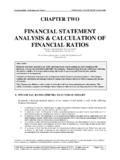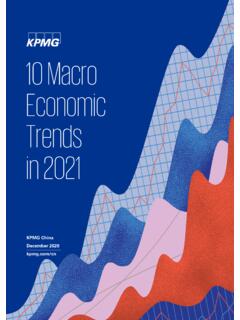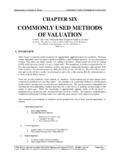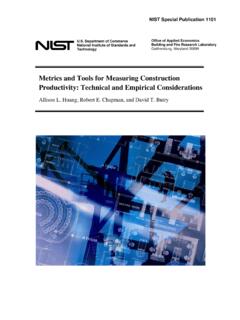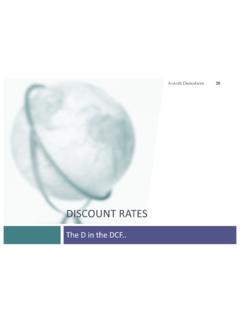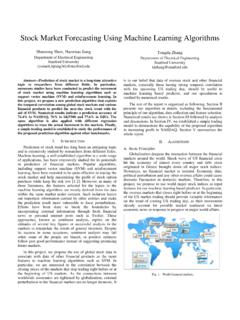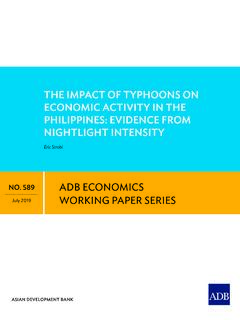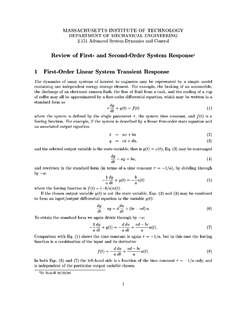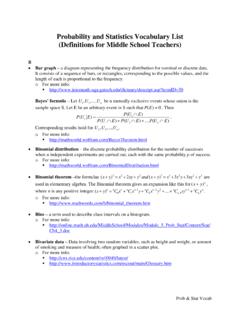Transcription of GaBi Paper Clip Tutorial
1 Part 1 Introduction to LCA and modelling using GaBi GaBi Paper clip Tutorial PE INTERNATIONAL Hauptstra e 111-115 70771 Leinfelden-Echterdingen Germany Phone +49 [0] 711 34 18 17 0 Fax +49 [0] 711 34 18 17 25 E-Mail Internet 3 Table of Contents 1 Introduction to Life Cycle Assessment .. What is LCA? .. Industry .. Government .. Universities .. How is an LCA created? .. GaBi overview .. 102 Conducting Life Cycle Assessments .. Goal and Scope Definition .. Goal .. Scope .. Life Cycle Inventory .. General .. Data Collection - Classifications .. Calculation of the LCI.
2 Life Cycle Impact Assessment .. Impact Assessment Methods .. Selection of Impact Categories .. Classification .. Characterization .. Optional elements of an LCA .. Interpretation .. Identification of significant issues .. Evaluation .. Conclusions, recommendations and reporting .. Report .. Critical Review .. 273 Procedure .. 2805 Connecting and activating a database .. Opening GaBi .. Connecting a DB .. Activating a DB .. 2906 Understanding flows .. Plans, processes and flows .. Flows .. 3107 Creating a plan and adding processes .. Starting a project .. Creating a plan .. Adding a process .. 34 4 Searching for processes.
3 3508 Creating a new process and process types .. Creating a new process .. 5 Process types .. u-so .. u-bb .. agg .. p-agg .. aps .. Specifying process type .. 3909 Adding input flows .. 4010 Creating a new flow and adding amounts .. Creating a new flow .. Adding a quantitiy to a flow .. Entering flow amounts .. 4711 Elementary and non-elementary flows and tracking .. Elementary & non-elemntary flows .. Flow types in GaBi .. Tracked flows .. Waste flows .. Specifying flow type .. 5012 Fixing the reference process .. 5213 Using auto-connect and adding transport .. Showing tracked flows .. Adding a process to a plan .. Using auto-connect.
4 Adding a transport process .. Process parameters .. Resizing process boxes .. 5614 Linking processes .. 5715 Adding a plan to a plan .. Creating a recycling loop .. 6216 Adjusting visual appearance .. Editing flows .. Adding comments .. 6317 Creating a balance and viewing dashboards .. Creating a balance .. GaBi Dashboard .. 6518 Creating a custom dashboard .. Creating a chart .. Editing chart options .. Saving the dashboard .. 70 5 19 Working with the balance tab .. LCI view .. Navigating the balance .. Changing the quantity .. The quantity view .. 7720 Analyzing weak points .. Relative contribution .. 7921 Exporting results and charts.
5 81 6 Table of Figures Figure 1: Overview of Life Cycle Assessment .. 9 Figure 2: Steps of a Life Cycle Assessment According to ISO 14044 ..11 Figure 3: Process Flow Diagram ..14 Figure 4: System Boundaries..15 Figure 5: Allocation Example ..16 Figure 6: Data Collection and Calculation Process ..18 Figure 7: Example Data Collection Sheet ..19 Figure 8: Classification and Characterization ..20 Figure 9: Comparison of the TRACI and CML Methods ..21 Figure 10: Characterization Example ..22 Figure 11: Normalized impact categories for different regions ..23 7 Nomenclature Abbreviation Explanation AP Acidification Potential CML Centre of Environmental Science, University of Leiden, the Netherlands EP Eutrophication Potential GaBi Ganzheitlichen Bilanzierung (German for holistic balancing)
6 GWP Global Warming Potential ISO International Organization for Standardization LCA Life Cycle Assessment LCIA Life Cycle Impact Assessment ODP Ozone Depletion Potential POCP Photochemical Ozone Creation Potential TRACI Tool for the Reduction and Assessment of Chemical and other Environmental Impacts 8 Purpose of this Handbook The purpose of this handbook is to support your learning about Life Cycle Assessment (LCA). We understand that learning new concepts can be difficult. And everyone has different ways of learning. Some people react best to visual learning, some aural. Some need to draw relationship charts.
7 Some need to read and read and read and some are lucky enough just to absorb everything. Through the GaBi Learning Centre we re trying to provide ways of learning that appeal to most of you. This handbook is intended to support the video tutorials found in the GaBi Learning Centre but can also be used completely independent from them. After completing the video tutorials or stepping through the content contained in this handbook you should: Understand the concept of LCA; Be able to build an LCA model using the GaBi software. Please note that one example (a Paper clip ) is used throughout the video Tutorial series and this handbook.
8 Startint with chapter 3 the Tutorial will outline a step-by-step procedure for conducting an LCA in GaBi. It contains two types of text: 1. Numbered text indicates that a step should be completed. Text in italics provides explanatory comments about why you might do something or how something works. You will also notice that there are headings scattered throughout the procedure. These correspond (mostly; there are a couple of extra headings here) with the contents found in the video Tutorial . The titles let you know what video chapter you are up to. Introduction to Life Cycle Assessment 9 1 Introduction to Life Cycle Assessment This section of the handbook introduces the concept of Life Cycle Assessment (LCA).
9 Videos 2, 3 and 4 of the GaBi Paper clip video Tutorial series accompany it. Figure 1: Overview of Life Cycle Assessment What is LCA? There are two LCA standards created by the International Organization for Standardization (ISO): the ISO 14040 and ISO 14044. Life Cycle Assessment, as defined by the ISO 14040 and ISO 14044 is the compiling and evaluation of the inputs and outputs and the potential environmental impacts of a product system during a product s lifetime. Who uses LCA? LCAs are used by a variety of users for a range of purposes. According to the ISO standards on LCA, it can assist in: Identifying opportunities to improve the environmental aspects of products at various points in their life cycle; Decision making in industry, governmental or non-governmental organizations ( strategic planning, priority setting, product and process design or redesign); Selection of relevant indicators of environmental performance, including measurement techniques; and Marketing ( , an environmental claim, eco-labeling scheme or environmental product declarations).
10 Introduction to Life Cycle Assessment 10 The following is just a brief list of the groups that use LCAs and of the possibilities that an LCA could be used for. Industry Large companies use LCAs as a way of identifying environmental hot spots and to develop and advertise their environmental management strategies. LCA studies are often conducted by industry associations and environmental concepts and tools research organizations including the: Canadian Wood Council; International Copper Association; International Lead and Zinc Research Organization; International Iron and Steel Institute; International Aluminum Institute and the Nickel Development Institute.
